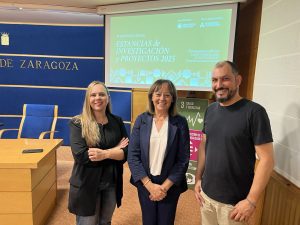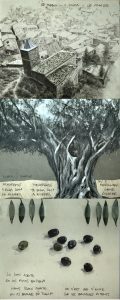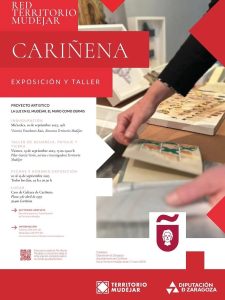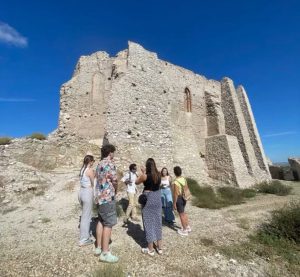
Territorio Mudéjar has awarded three research stays and four runners-up prizes to carry out innovative projects that contribute to the development of the partner towns through the responsible and sustainable use of cultural and natural heritage resources.
This is the fourth call for applications for the stays named after Gonzalo M. Borrás Gualis as a tribute to the distinguished professor and expert in Mudejar art. Each of the stays is endowed with 6,000 euros and each runner-up with 4,000 euros.
The projects selected by a team of interdisciplinary experts range from the creation of a white book to conserve traditional architecture, the drafting of a digitalisation strategy, sound contexts in the Mudéjar through early music, a strategy to make the Mudéjar heritage visible to the Muslim public, the study of the geometric elements of Mudéjar churches, the creation of analysis maps of the partner towns and the study of light in the Mudéjar through drawing and painting.
These projects are in addition to the 16 from previous editions and the more than 36 professionals who have formed the network of researchers of the stays since they were launched in 2019 and who have provided new perspectives on the management of Mudejar heritage, have had a positive impact on the villages and have promoted an interdisciplinary work network. In addition, specifically, they have improved the knowledge of the Mudejar as World Heritage and the benefits it brings as an international brand recognised by Unesco.
The selected stays are:
1-“Prevention and conservation from urban planning: development of a tool for the protection of traditional architecture”. Javier Gómez Patrocinio (PhD in Architecture, Polytechnic University of Valencia) proposes the development of recommendations, in the form of a white paper, to serve as a framework for implementing criteria for the conservation of local traditional architecture in urban planning management.
2-“Mudejar Smart 3D. Digitalisation strategy for the Mudejar territory”. Gian Luca Vita (Politecnico di Milano) and Marco Luchini (Politecnico di Milano and Federico II University of Naples) propose the creation of a series of three-dimensional models for
test the implementation of a way of working with the heritage digitisation process that is useful when generating new projects. They plan to draft a digitisation strategy for Territorio Mudéjar that is adapted to the specific circumstances of the territory and its heritage.
3-“Contextos sonoros y arte mudéjar, una aproximación incipiente desde la interpretación históricamente informada (ss. XVI-XVIII): ecos del pasado y proyecto de futuro” (Sound contexts and Mudejar art, an incipient approach from historically informed interpretation (16th-18th centuries): echoes of the past and a project for the future). The musicians and researchers Carlos Bonal, Miguel Bonal and Carlos González (University of Granada, Royal Conservatory of The Hague and University of Castilla La Mancha) aim to generate new artistic contexts through the study of early music and the original acoustics of the Mudejar heritage space and to reflect on the possibilities for the future of this heritage as a space linked to musical practice.
The selected runners-up are:
1-“Assessment of the muslim-friendly potential of Territorio Mudéjar for the reception of knowledge tourism”. Bárbara Ruiz Bejarano, PhD in Arab and Islamic Studies (University of Alicante and Las Fuentes Foundation) studies the opportunity to make Aragon’s great Mudejar heritage visible to Muslim tourists, based on a new form of knowledge tourism, of higher quality, centred on heritage, history and its contemporary heritage through the “Halal” tradition.
2-‘Mudéjar RGB’. Víctor Solanas-Díaz, PhD in Art History (University of Zaragoza), will study in depth the geometric elements used on the exterior of the main Mudéjar churches to obtain a study of the rhythm through a series of ‘motifs’ that he will then take as a reference in the artistic interventions that he will develop linking the Mudéjar heritage and its translation to different museums and art galleries in Spain.
3-‘Mudejar landscape’. Javier Montori Montolar and Esteban Lahoz Montolar, graduates in Fine Arts (University of Barcelona) and Master PhotoEspaña, propose to digitise the terrain and morphology of the villages through a series of analysis cartographies (the starting point will be a photogrammetric survey of the village). With this, they aim to create a sustainable tool that contributes to heritage conservation and attracts the scientific and educational community.
4-“Mudejar as dermis. Light in Mudejar art”. The artist and plastic arts researcher Pilar García Verón (Complutense University of Madrid) seeks to bring the public closer to Mudejar art through the study of its aesthetic variables. Through drawing and painting, she aims to capture a specific stage in the temporal and spatial development of light in order to show how it dematerialises form.
Territorio Mudéjar celebrates its fourth anniversary as a model of success
Territorio Mudéjar celebrates this week its fourth anniversary as an association of town councils, currently 40 member municipalities and one collaborating partner, whose objective is to consolidate a unified and collaborative management network for the use of the historical and artistic resources linked to the important Mudejar heritage, understanding them as an engine for the development of the villages and as an element of identity for the maintenance of the communities that make up our territory.
As a result of these four years of work, Territorio Mudéjar has become a model of good innovative practices at international level (it is taken as a model of successful management, for example, in the regions of Groningen -Netherlands-, in the Heritage Lab project of the Libau Foundation, and in South Bohemia -Czech Republic-). It has also been selected by the Ministry of Culture to present the entity as a management model at the 16th Meeting of World Heritage managers to be held on 28 and 29 September in Mérida.



